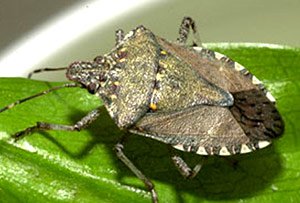The scientists working to conquer brown marmorated stinkbug are looking for homeowner volunteers in the Mid-Atlantic States to count stinkbugs.
They want these citizen scientists to count the number of stinkbugs they see on the exterior of their homes once a day every day from September 15 to October 15.
Tracy Leskey, the research entomologist at the Appalachian Fruit Research Station in Kearneysville, West Virginia, who coordinates the effort, said they know from reports that some homeowners see tens of thousands of stinkbugs on their homes while other homes near by have very few.
“We don’t know if it’s the color of the building, or its elevation on a ridge, or the habitat and vegetation around it,” she said. “We’re trying to understand the nature of hot spots and potentially develop management tools based on these patterns.”
Last year, she said, one shed in Virginia attracted 100,000 brown marmorated stinkbugs, but no one knows why the bugs liked that building.
Volunteers will get forms to fill out, recording how many stinkbugs they see each day and then describe the building, its location, and the habitat around it.
She’s looking for volunteers primarily in eastern West Virginia, Virginia, and Maryland, but anyone willing to count the bugs is welcome.
Volunteers can contact her through email at tracy.leskey@ars.usda.gov, or call the Appalachian Fruit Research Station at (304) 725-3451 and talk to Doo-Hyung Lee or Torri Hancock.
Since the stinkbug epidemic began in 2010, Leskey said, they’ve learned a lot about the bug—the odors it responds to, the host plants it prefers, and where it overwinters. In the future, she hopes this will lead to attract and kill strategies where stink bugs that gather at particular locations can be wiped out. This could greatly reduce the need to spray orchards, where IPM programs have been damaged by the need to use chemicals that are harsh on beneficial insects.
About the beginning of September, stinkbugs begin to finish the voracious feeding that bulks them up for the winter. “They start to look for places that are cool, tight, and dry,” she said. In woodlands, that tends to be standing dead trees. But they are very much attracted to manmade structures.
By mid-October, most of the feeding activity has ended as the nymphs of the last generation mature.
The bugs are capable of moving great distances. “In our dispersal studies, we find they can easily fly a mile or two each day. One of them flew 75 miles in one day,” Leskey said. “Nymphs move, too. They walk.”
Fruit crops, like apples, are very vulnerable because they become sweet and juicy toward the end of the season, when seedpods on wild plants are drying out and becoming less palatable.
As part of the Specialty Crop Research Initiative funding for the project, a Web site, www.stopbmsb.org, has been established to gather information in one place. A series of videos and fact sheets outline what scientists have learned about the stinkbug in the last few years.


Leave A Comment